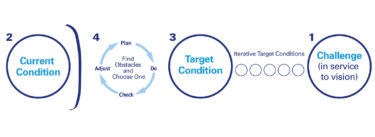Editor’s Note: This article was originally published May 18, 2010. It is the third of six in a series focused on exploring lean transformation.
One of my favorite value-stream walks is with the senior managers of several organizations who share and jointly manage a value-creating process that stretches all the way from raw materials to the end customer. I’ve been taking walks of this sort for more than 20 years and I usually see the same thing: Smart, hard working managers, each trying to optimize their portion of the value stream and wondering why there is so much inventory, interruption, and waste along the stream and why it is so hard to truly satisfy the customer waiting at the end.
This is what I usually see because we live in a world where everything is oriented vertically – departments, functions, enterprises, and, very important, individuals – despite the fact that the flow of value to the customer is horizontal across all the departments, functions, and enterprises. And – here’s the really odd part — every manager and employee touching the value stream knows intuitively, just below the surface, that value flows horizontally and that customers have no interest at all in the vertical constraints interrupting the flow.
So what’s the problem? Why is it so hard for us to act horizontally rather than just work around (or simply ignore) the enormous problems of being vertical?
I hate to say, but the problem begins with you and me. We are all points along the stream, standing tall in our own estimation, and our first objective is to optimize ourselves, our own point! Given this, it’s not surprising that we first seek to optimize our department (where our boss, our personnel evaluation, and our career path reside) and then our function and then, maybe, our enterprise, with no energy left over for optimizing the whole stream.
But let’s not be too hard on ourselves. Our personal objectives, compensation and career trajectories strongly direct us to look up, for fear of falling down, rather to look from side to side in hopes of doing better. We aren’t so much bad people – at least I’m not! – but good people working in a bad management process. However, unless we can devise a new framework for thinking together about the horizontal flow of value in a way that makes everyone better off, we will all continue to act as we always have. The predictable result is frustrating work lives and an exasperating experience for customers.
How can we do better? The first step is simple. Take a walk together along the stream to see, and to reach agreement on, what is really happening and the problems the current state causes managers, employees, and customers. Then draw a map that everyone touching the stream can see and post this as the baseline. This step always produces amazement and then relief that all of the dysfunctions and conflicts are finally out in the open.
Next, assign someone to lead a team involving every function and firm touching the value stream to envision a value-creating process that better solves customer problems while saving time and money. Then ask why this can’t be created and seek the root cause. Part of the problem may be technical and some outside help may be needed when skills are lacking. But in my experience the critical problems are more likely to be organizational across multiple functions and enterprises. For example, money may need to be spent at one point (for facilities, equipment, training, new packaging of goods, etc.) and behaviors may need to change at this or other points to create a better result for the whole stream.
But why would the managers of the factory or the warehouse or the retailer do this when all of the benefit goes to one or a few points elsewhere along the stream? And why would employees cooperate in rethinking work when they may individually have more work or no work at all? The answer, of course, is that they won’t and everyone involved will spend their time instead on explanations of why the failure to improve performance is everyone else’s fault. A classic prisoner’s dilemma in which everyone gets to stay in their vertical jail!
So the job of the value-stream leader – who it should be noted has no authority over most and perhaps all of the departments and firms involved – is to take responsibility for the performance of the whole value stream and discover ways to make everyone along the stream whole as the stream is improved. In the end the senior leaders of all the departments, functions, and firms will need to agree with the plan, arrange compensation mechanisms for those who would otherwise be losers, and make sure that everyone touching the stream has incentives aligned with the goal of optimizing the stream. But the first step is to raise consciousness, create the vision, highlight the problems to be overcome, identify the costs of improvement along with the benefits of success, and describe the ways to offset costs with benefits to achieve a positive sum solution. Without this first step, starting with a simple walk together, we will all continue along our vertical path, where value stream performance is a stagnant, horizontal line.
Best regards,
Jim
James P. Womack
Founder and Senior Advisor
Lean Enterprise Institute, Inc.
Management Systems
Connecting Strategy, Operations, and Problem Solving Across Your Organization.







All these words are still true and aiming to the most important thing in the organizations who are not creating so much value as it should be. Only the real practicer who decrease the obstacles in the organizations will be eventually successful even so many companies are speaking and implementing lean.